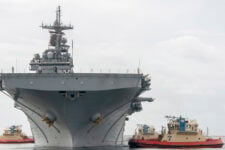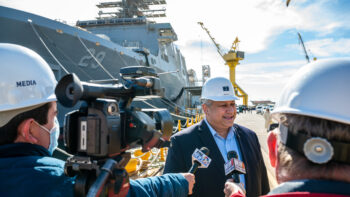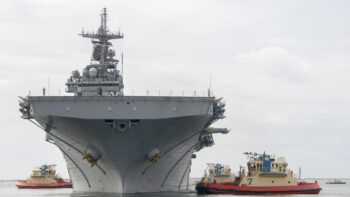 Washington: Last week was a tough one for backers of the Navy’s aircraft carriers.
Washington: Last week was a tough one for backers of the Navy’s aircraft carriers.
During last Tuesday’s hearing of the House Armed Services readiness subcommittee, Chairman Randy Forbes (R-VA) asked point blank whether or not the sea service was looking to kill off parts of its carrier fleet.
The official response from the heads of the Navy’s readiness and sea systems command to the question: dead silence.
A day later, Vice Chairman of the Joint Chiefs of Staff Gen. James Cartwright added more fuel to the fire when he admitted that Navy and Pentagon officials were considering cancellation of the Ford-class carriers as a way to strip roughly $10 billion in Navy spending.
Navy Secretary Ray Mabus and Chief of Naval Operations Adm. Gary Roughead have repeatedly backed the Ford-class carrier, noting the key role it will have in future Navy operations. They are, after all, the top leaders of the Navy and nothing seems to matter more to admirals and their friends than a big aircraft carrier.
But after reading the news coverage of the Forbes hearing and Cartwright’s comments, that unified front seemed to be showing more cracks than the hull of the Littoral Combat Ship.
But you cannot believe everything you read, says a close watcher of things congressional.
Axing the Ford-class from the Navy’s inventory was only one option among many the Pentagon is looking at. An option, the source pointed out, the department opted to let loose into the public domain.
Is the choice to terminate the Ford-class carrier on the table, as a way to get to the deficit reduction goals set by the White House? Yes. Is it the only option on the table? No, says the congressional watcher.
To prove the point, the watcher noted that Cartwright also mentioned that DoD could consider a return to the draft, as a way to draw down costs. (Now that would set Capitol Hill afire but we don’t expect it to happen, at least not yet…)
But if the Navy does decide to draw down its carrier fleet below 11 ships, the service’s “Gator Navy” — as the Marines’ amphibious fleet is known — would be able to pick up the slack, defense consultant and former NSC staffer Robbin Laird said. (Laird is a member of the Breaking Defense Board of Contributors.)
The Navy could pair up its new Littoral Combat Ships with Amphibious Ready Groups and that combination could be just as effective as an aircraft carrier. ARG ships can already launch V-22 Ospreys, helicopters and AV-8B Harriers.
The scenario only gets better once the F-35B hits the decks of those ships, Laird said.
While some may be wringing their hands over the future of the carrier fleet, the service and the Office of Secretary of Defense actually have a tremendous “transitional opportunity,” Laird said, to reshape both its amphibious and aircraft carrier fleets in a way that would keep both viable for years to come. And provide more decks in more places.
Marines eye 2025 fielding of 3 new, mobile air defense systems
“We are on track from a programmatic standpoint — cost, schedule performance — but we’re always gonna be late to need,” said Col. Andrew Konicki, the program manager for Ground Based Air Defense (GBAD). “The threat is ever changing and ever evolving.”




























